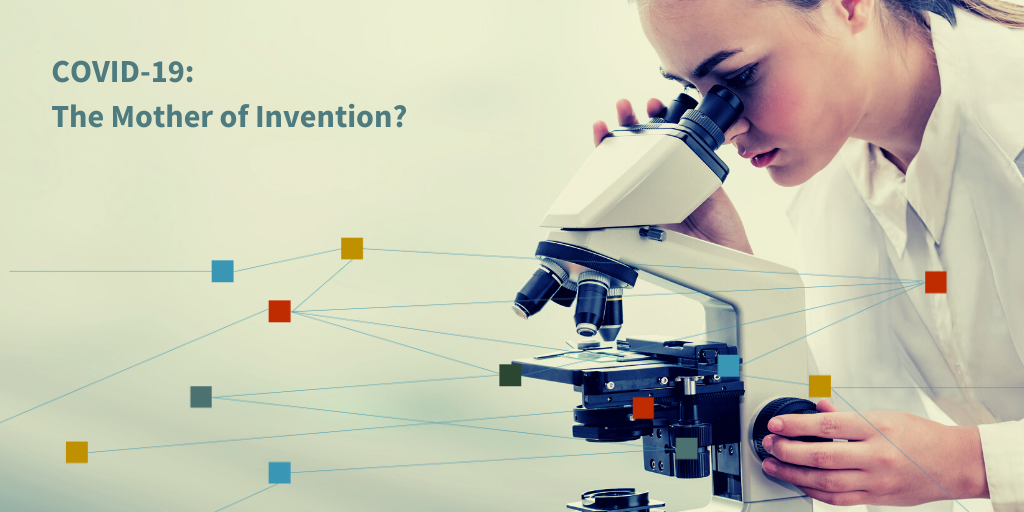
Necessity is the mother of invention, and during these trying times, necessity’s name is COVID-19. The pandemic caught most of the world by surprise, spreading and mutating before scientists could grasp the full potential of the disease and its effects. Those effects, as we’ve discovered, aren’t just physical illness and possible death, but also economic devastation.
If there is a bright side to this, it’s that innovation is surging. In an effort to beat an unseen foe, scientists, engineers, and inventors have increased time, investment, and thought for the benefit of all in the form of innovations that fight the pandemic on all sides—medically, financially, and even politically.
A History of Adversity and Innovation
This increase in forward thinking—or even simply reactive thinking—isn’t novel. Throughout history, plagues, wars, and other hardships have driven innovation out of the necessities they create, beginning with the Black Plague in the 1300s.
Out of an illness that ravaged a continent and killed up to 60% of the population, we got the first timekeepers—hourglasses that later became clocks. These timekeepers were in answer to the need for human labor after so many deaths, a way to protect workers with reasonable working hours and a higher hourly wage. New tools and automation processes were invented to make that labor easier and more efficient.
After the Black Death, we also saw the first foray into healthcare based on science and experimentation instead of religion. Phew! Where would we be today if we hadn’t had a Great Plague to spur us toward modern medicine?
In the late 1700s, the scourge of smallpox brought about the introduction of vaccines. Cholera outbreaks led to improved sanitation and drinking water facilities. The Great Flu Epidemic of 1918, unfairly referred to as the Spanish Flu, introduced the very social distancing we’re practicing today in the hopes of eradicating COVID-19.
We are currently in a medical war with the enemy COVID-19. However, non-medical wars have also advanced innovations. The Civil War gave the world the telegraph, which was developed to send and receive military communications. World War I gave us air traffic control, which is still, of course, used to this day. We also saw the invention of mobile X-ray machines, thanks to Marie Curie. World War II saw the rise of jet engines, synthetic rubber and oil, and radar.
The point is, innovation is often the answer to adversity, and what we’re experiencing today is nothing new—and yet everything new.
Coronavirus Innovations Spring Forth
Indeed, we already had several innovations before the virus took hold that have made our now-isolated lives easier. Ecommerce, streaming services, wireless internet—or even internet in general (what on Earth would we do today without the internet?)—make shopping, working, and entertaining ourselves possible while the brick-and-mortar establishments of the world close down.
It’s not enough to maintain our current status quo. We must best the virus, rebuild the economy, and possibly even improve our future, and several innovators are already on the way.
Virus-Killing Robots
First, there are UVD Robots from Denmark, which are able to disinfect patient rooms and operating rooms in hospitals to give healthcare workers a better chance at avoiding exposure to the virus. Each robot emits powerful, short wavelength lights with enough energy to destroy the DNA or RNA of dangerous microorganisms. While it’s true that UV disinfecting technology has been around for a while, only recently has it been put to work eradicating the novel coronavirus.
Free Emergency Ventilator Technology
Also on the list of “innovations that have been here a while but have been revived due to COVID-19” is the emergency ventilator developed by a team at MIT. These small, simple ventilator devices were first conceived a decade ago in a Medical Device Design class and can be built with parts worth around $100—total. All of the information about how to build and operate an emergency ventilator is freely available here.
Faster Testing Through CRISPR Tech
In a race against time, scientists scramble to develop accurate tests to detect the virus that also work quickly and efficiently. One such MIT scientist, Feng Zhang, also a previous winner of the Lemelson-MIT Prize for innovation, has created a protocol for using the CRISPR-based SHERLOCK technique for detection of COVID-19. The reading of such tests is simple and leaves little room for error, much like the operation of a pregnancy test.
Geo-Tracking the Virus
Another MIT-led project involves tracking the location of COVID-19 patients through their phones is in the works. The project would trace the movements of anyone who has been infected and those with whom they have interacted. The project requires people who have the virus and those who don’t to voluntarily download the app, which then can alert any users if they have come into contact with an infected person.
Various other inventions have come to light, as well. There’s the virus-killing snood, which claims to kill more than 95% of viruses, including COVID-19. We now have the ability to 3-D print hands-free door handles. Drones are delivering medical supplies more quickly than ambulances can to both remote and heavily populated areas. There is no end to the genius that is often born of adversity.
What remains to be seen, however, is how these innovations will continue to improve life as we know it after COVID-19 is finally eradicated. What invention—or new use of old technology—will enter our daily lives as did clocks, synthetic oil, and air traffic control?



